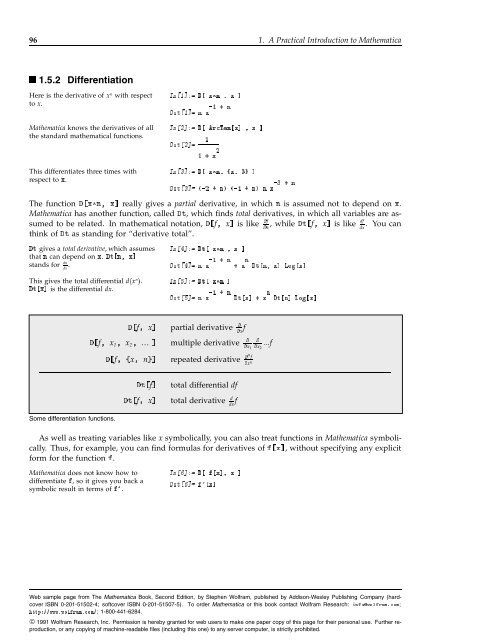1.5.2 Differentiation - Wolfram Research
1.5.2 Differentiation - Wolfram Research
1.5.2 Differentiation - Wolfram Research
You also want an ePaper? Increase the reach of your titles
YUMPU automatically turns print PDFs into web optimized ePapers that Google loves.
96 1. A Practical Introduction to Mathematica<strong>1.5.2</strong> <strong>Differentiation</strong>Here is the derivative of x n with respectto x.Mathematica knows the derivatives of allthe standard mathematical functions.This differentiates three times withrespect to x.In[1]:= D[ x^n , x ]-1 + nOut[1]= n xIn[2]:= D[ ArcTan[x] , x ]1Out[2]= -----------21 + xIn[3]:= D[ x^n, {x, 3} ]-3 + nOut[3]= (-2 + n) (-1 + n) n xThe function D[x^n, x] really gives a partial derivative, in which n is assumed not to depend on x.Mathematica has another function, called Dt, whichfindstotal derivatives, in which all variables are assumedto be related. In mathematical notation, D[f, x] is like @fdf, while Dt[f, x] is like . You can@x dxthink of Dt as standing for “derivative total”.Dt gives a total derivative, which assumes In[4]:= Dt[ x^n , x ]that n can depend on x. Dt[n, x]stands for dn . -1 + n ndx Out[4]= n x + x Dt[n, x] Log[x]This gives the total differential d(x n ).Dt[x] is the differential dx.In[5]:= Dt[ x^n ]-1 + n nOut[5]= n x Dt[x] + x Dt[n] Log[x]D[f, x]partial derivative @ @x fD[f, x 1 , x 2 , ... ] multiple derivative @@x 1D[f, {x, n}]repeated derivative @n f@x n@@x 2:::fDt[f]Dt[f, x]total differential dftotal derivative d dx fSome differentiation functions.As well as treating variables like x symbolically, you can also treat functions in Mathematica symbolically.Thus, for example, you can find formulas for derivatives of f[x], without specifying any explicitform for the function f.Mathematica does not know how todifferentiate f, soitgivesyoubackasymbolic result in terms of f'.In[6]:= D[ f[x], x ]Out[6]= f'[x]Web sample page from The Mathematica Book, Second Edition, by Stephen <strong>Wolfram</strong>, published by Addison-Wesley Publishing Company (hardcoverISBN 0-201-51502-4; softcover ISBN 0-201-51507-5). To order Mathematica or this book contact <strong>Wolfram</strong> <strong>Research</strong>: info@wolfram.com;http://www.wolfram.com/; 1-800-441-6284.© 1991 <strong>Wolfram</strong> <strong>Research</strong>, Inc. Permission is hereby granted for web users to make one paper copy of this page for their personal use. Further reproduction,or any copying of machine-readable files (including this one) to any server computer, is strictly prohibited.
1.5 Symbolic Mathematics 97Mathematica uses the chain rule tosimplify derivatives.In[7]:= D[ 2 x f[x^2], x ]2 2 2Out[7]= 2 f[x ] + 4 x f'[x ]Web sample page from The Mathematica Book, Second Edition, by Stephen <strong>Wolfram</strong>, published by Addison-Wesley Publishing Company (hardcoverISBN 0-201-51502-4; softcover ISBN 0-201-51507-5). To order Mathematica or this book contact <strong>Wolfram</strong> <strong>Research</strong>: info@wolfram.com;http://www.wolfram.com/; 1-800-441-6284.© 1991 <strong>Wolfram</strong> <strong>Research</strong>, Inc. Permission is hereby granted for web users to make one paper copy of this page for their personal use. Further reproduction,or any copying of machine-readable files (including this one) to any server computer, is strictly prohibited.
















